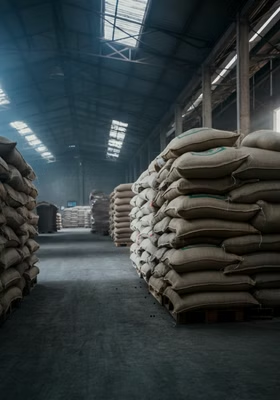2025 // Week 2 – Vietnam Pepper Market Market: Rising Prices and Export Challenges
Domestic Pepper Price Trends
 The Vietnamese pepper market has shown resilience and growth in recent months, with prices continuing their upward trajectory across key producing regions. As of the latest market data, pepper prices in the domestic market range from 152,000 to 153,000 VND/kg, reflecting a strong demand and potentially tightening supply.
The Vietnamese pepper market has shown resilience and growth in recent months, with prices continuing their upward trajectory across key producing regions. As of the latest market data, pepper prices in the domestic market range from 152,000 to 153,000 VND/kg, reflecting a strong demand and potentially tightening supply.
 According to a state-owned company based in Dak Lak, pepper prices have been rising since late November, coinciding with the peak coffee harvest season. Traditionally, this period has put pressure on pepper holders who require finances for coffee-related expenses. However, the current market dynamics seem to be bucking this trend.
According to a state-owned company based in Dak Lak, pepper prices have been rising since late November, coinciding with the peak coffee harvest season. Traditionally, this period has put pressure on pepper holders who require finances for coffee-related expenses. However, the current market dynamics seem to be bucking this trend.
An interesting historical perspective comes from farmers’ belief that pepper prices should be approximately twice the price of coffee. Currently, we observe domestic coffee prices at 120,500 VND/kg, while pepper stands at 150,000 VND/kg. This ratio, while not exactly 2:1, still indicates a strong relative value for pepper in the agricultural commodities market.
Looking ahead, experts are predicting long-term support for export pepper prices. This optimistic outlook is primarily driven by expectations of a decline in Vietnam’s 2025 pepper crop production. Such a scenario could further tighten supply and potentially drive prices higher in the coming year.
2025 Pepper Harvest and Supply Challenges
The 2025 pepper harvest in Vietnam is expected to face significant challenges, which could have far-reaching implications for the global pepper market. According to industry projections, the harvest will be almost fully completed by February, with some areas extending into March and April. This represents a delay of 1-2 months compared to the usual harvest timeline, primarily attributed to prolonged drought conditions.
 This delay in harvest is expected to make pepper supply increasingly difficult, potentially creating a supply squeeze in the early months of 2025. The Vietnam Pepper and Spices Association (VPSA) has reported that household-held pepper reserves are nearly depleted, with remaining stocks mostly concentrated in agent and enterprise warehouses.
This delay in harvest is expected to make pepper supply increasingly difficult, potentially creating a supply squeeze in the early months of 2025. The Vietnam Pepper and Spices Association (VPSA) has reported that household-held pepper reserves are nearly depleted, with remaining stocks mostly concentrated in agent and enterprise warehouses.
A detailed analysis of inventory levels provides further insight into the supply situation:
-
- Combined inventory from the 2023 crop and 2024 imports is estimated at 40,000 – 45,000 tons
- This figure includes informal imports
- Export supplies by the end of 2024 are lower than in previous years
- Supply is expected to improve only in March 2025 with the onset of the 2025 harvest
 *Adding to these supply challenges is the increasing competition pepper cultivation faces from alternative crops. Notably, durian and coffee farming are becoming more attractive to farmers, potentially leading to a reduction in land dedicated to pepper production. This shift in agricultural focus could have long-term implications for Vietnam’s pepper industry and its position in the global market.
*Adding to these supply challenges is the increasing competition pepper cultivation faces from alternative crops. Notably, durian and coffee farming are becoming more attractive to farmers, potentially leading to a reduction in land dedicated to pepper production. This shift in agricultural focus could have long-term implications for Vietnam’s pepper industry and its position in the global market.
December 2024 Export Performance
The VPSA has released preliminary statistics for Vietnam’s pepper exports in December 2024, providing valuable insights into the industry’s performance at the close of the year. These figures offer a snapshot of the market dynamics and help set expectations for the coming year.

Breaking down the export figures:
- Black pepper exports: 12,771 tons, generating $81.5 million in revenue
- White pepper exports: 2,494 tons, contributing $19.1 million to the total revenue
Compared to November, these figures represent a 4.3% decrease in export volume and a 5.5% drop in export revenue. This slight decline could be attributed to seasonal factors or changes in global demand patterns.
Average export prices for December 2024:
- Black pepper: $6,476/ton, down 0.6% from the previous month
- White pepper: $8,198/ton, down 1.1% from November
The United States maintained its position as Vietnam’s largest export market for pepper in December, accounting for 29.5% of exports (4,509 tons). However, this represents an 11.4% decrease from November, indicating potential fluctuations in demand from this key market.
2024 Annual Export Summary
The year 2024 marked a significant period for Vietnam’s pepper industry, characterized by volume contraction but substantial revenue growth. This paradoxical performance underscores the complex dynamics at play in the global pepper market.

Detailed breakdown of 2024 exports:
- Black pepper: 220,269 tons, generating $1.117 billion in revenue
- White pepper: 30,331 tons, contributing $200.6 million to the total revenue
Compared to 2023, the export volume decreased by 5.1%, but export revenue surged by an impressive 45.4%. This significant revenue growth despite lower volume suggests a substantial increase in pepper prices throughout the year.
Average export prices for 2024:
- Black pepper: $5,154/ton, up 49.7% from 2023
- White pepper: $6,884/ton, up 38.9% from the previous year
These price increases reflect a combination of factors, including tightening global supply, increased production costs, and potentially higher demand in key markets. The substantial price growth has more than offset the decrease in export volume, resulting in a highly profitable year for Vietnam’s pepper industry.
Key Export Markets and Product Segmentation
Understanding Vietnam’s pepper export markets and product segmentation is crucial for assessing the industry’s global position and identifying growth opportunities. The data reveals interesting patterns in both geographical distribution and product preferences.
Top White Pepper Importers
White pepper, known for its distinct flavor profile and higher price point, has its own set of key markets:


China also features prominently in the white pepper market, importing 1,982 tons in 2024. This diversification across both black and white pepper markets demonstrates the versatility of Vietnam’s pepper industry and its ability to cater to various global preferences.
China’s Import Trends
China, a significant player in the global spice trade, ranked 6th in importing Vietnamese pepper in 2024. Key statistics for China’s imports:
- Total import volume: 10,549 tons
- Year-on-year change: 82.4% decrease
- Market share: 4.2% of Vietnam’s total pepper exports
The substantial decrease in imports from China could be attributed to various factors, including changes in domestic demand, shifts in trade policies, or increased competition from other pepper-producing countries.
International Pepper Market Overview
The global pepper market, as reported by the International Pepper Community (IPC), shows a dynamic landscape with varying prices across different origins and grades. This international context is crucial for understanding Vietnam’s competitive position and potential market opportunities.

The IPC’s evaluation of the pepper market in the first week of 2025 indicates promising prospects, with no country reporting a price decline. This positive start to the year suggests a strong global demand for pepper, which could benefit major producing countries like Vietnam.

